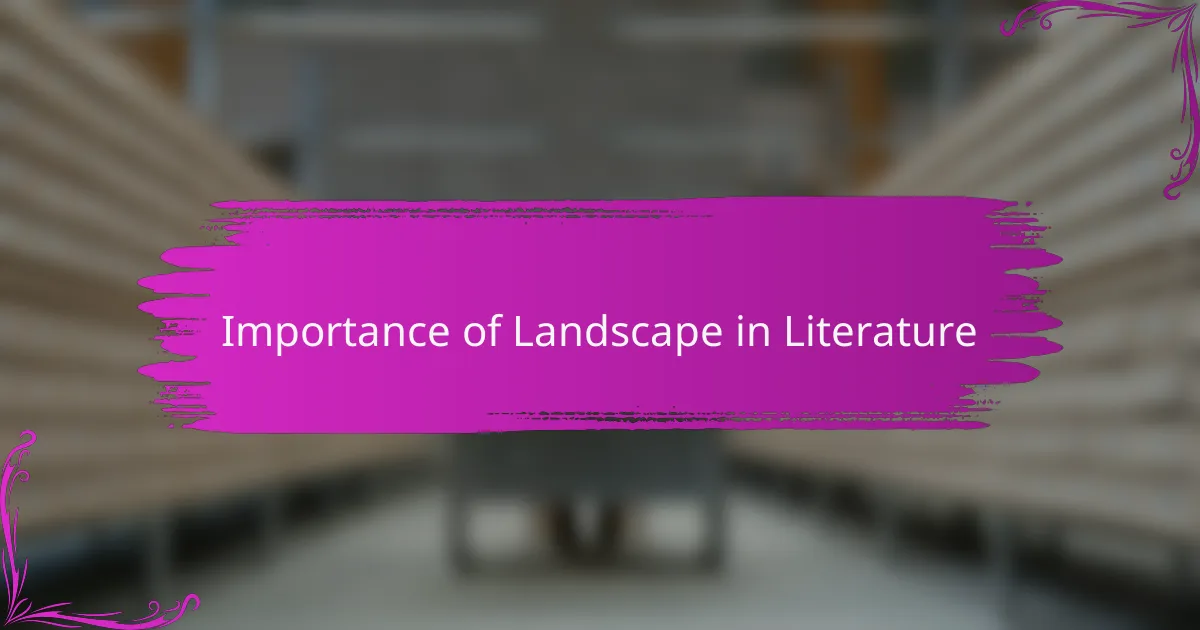Key takeaways
- Steinbeck’s landscapes serve as vital characters, reflecting the emotional states and struggles of his characters.
- Nature’s beauty and brutality amplify the narrative’s thematic depth, evoking strong sensory experiences for readers.
- Personal connections to the landscapes enhance reader engagement and prompt reflections on one’s own environment.
- Creative activities, such as visual collages and poetry, can deepen understanding and appreciation of Steinbeck’s themes.

Understanding Steinbeck’s Landscapes
Steinbeck’s landscapes are not mere backdrops; they become vital characters in his narratives. For instance, when I first read “The Grapes of Wrath,” the arid expanses of Dust Bowl imagery struck me profoundly. The parched earth encapsulated not just physical desolation but also the emotional turmoil of the characters struggling for survival and hope, illustrating how Steinbeck masterfully intertwines setting and story.
In “East of Eden,” the Salinas Valley is vivid in my memory. I could almost smell the rich soil and feel the warmth of the sun on my skin as I immersed myself in the lives of the Trask and Hamilton families. Steinbeck’s detailed portrayal of the valley as both a beautiful and at times harsh environment didn’t just tell a story, it drew me into the dynamics of family, choices, and fate.
- Landscapes are portrayed with depth and emotion, serving as reflections of characters’ inner lives.
- Nature’s beauty and brutality underscore the themes of struggle and resilience.
- Steinbeck’s descriptions evoke strong sensory experiences, allowing readers to visualize and feel the settings deeply.
- Personal connections to the landscapes can enhance reader engagement, making their experiences with the text more meaningful.
- His use of the natural world can prompt readers to reflect on their own connections with their environments.

Importance of Landscape in Literature
Landscape plays a crucial role in literature, often serving as more than a mere backdrop to the story. I remember feeling a tangible connection to the land in Steinbeck’s works; it was as if the vast fields, valleys, and harsh terrains mirrored the struggles of his characters. Have you ever found yourself drawn into a setting, feeling its emotions as vividly as those of the characters? That’s the magic of landscape in literature—it resonates with our own experiences.
In my reading journey, I’ve noticed that when nature is depicted with both beauty and brutality, it amplifies the narrative’s emotional depth. Think about the Dust Bowl’s barren stretches in “The Grapes of Wrath.” It wasn’t just a description of a place; it represented the hope and despair of the people who traversed it, each crack in the soil echoing their hardships. When a landscape comes alive like this, it challenges us to confront our own resilience and the realities of our environment.
Steinbeck’s landscapes often evoke sensory images that linger long after the book is closed. I can still feel the warmth of the sun and the richness of the Salinas Valley as I navigated through the lives entangled in its embrace. This personal connection doesn’t just enhance my reading experience; it resonates with a universal truth—we all have landscapes that shape us. Isn’t it fascinating how these descriptions can incite such strong emotions and reflections on our own lives?

Key Themes in Steinbeck’s Works
Steinbeck’s works consistently explore themes of human struggle and resilience through the lens of the landscapes he describes. I often find myself wondering how an author can evoke such raw emotion through mere descriptions of land. When I read “The Grapes of Wrath,” I felt the weight of the Dust Bowl—not just as a setting, but as a character itself, forcing people to confront their limitations and the relentless nature of hope amidst despair.
Another theme that stands out in Steinbeck’s writing is the connection between humanity and nature. I remember vividly the lush descriptions of the Salinas Valley in “East of Eden.” It felt alive, filled with potential and underscored by the harsh realities of existence. The way he juxtaposes the beauty of the land with the struggles of his characters really drives home the idea that our environments deeply influence our stories and decisions.
Lastly, the empathy that Steinbeck infuses into his landscapes serves as a reminder of our shared experiences. Isn’t it remarkable how a place can evoke such strong feelings of belonging or alienation? I often reflect on my own ties to the landscapes I’ve known; like Steinbeck, I believe that these connections shape who we are. By revealing the intricate relationship between his characters and their environments, Steinbeck invites us to examine our own connections with the places we inhabit.

Techniques for Analyzing Landscapes
One effective technique for analyzing landscapes in Steinbeck’s literature is to consider the emotional weight they carry. For example, I recall feeling the weight of the Dust Bowl in “The Grapes of Wrath.” It wasn’t just dust; it symbolized despair and resilience. When a landscape evokes such strong feelings, it opens a dialogue about what it means to navigate struggles in our own lives.
Another practical approach is to note how Steinbeck intertwines nature with character development. The Salinas Valley isn’t just a picturesque setting; it shapes the identity of characters like the Trasks and Hamiltons. I often found myself reflecting on my experiences in familiar places—how certain landscapes have influenced my choices or moods. When I see how intimately Steinbeck connects the characters to their environment, it prompts me to ask: How do my surroundings reflect my inner world?
Finally, examining sensory details in Steinbeck’s writing can enhance the analysis of landscapes. I remember feeling the warmth of the sun, hearing the whispers of the wind through the fields. These sensory experiences are gateways to emotional engagement. By immersing ourselves in these details, we not only visualize the settings but also forge a deeper connection to the themes within the narrative. How do the landscapes you encounter in literature resonate with your personal experiences? Exploring these connections can enrich our understanding of both the text and ourselves.

Personal Reflections on Steinbeck’s Landscapes
As I delved into Steinbeck’s landscapes, I found myself not just reading about the Salinas Valley or the dusty roads of California, but truly feeling them. I recall the moment I first experienced the raw beauty of Steinbeck’s descriptive prose; it was as if the fields were alive, whispering stories of hardship and hope. The way he paints the natural world intertwines with human struggle resonated deeply with my own experiences in nature, reminding me of my childhood hikes where each vista told a story of resilience.
In Steinbeck’s work, landscapes are more than mere backgrounds; they are characters in their own right. I remember feeling the warmth of the sun on my skin while picturing the same sunlit hills he described. It was in those moments that I understood how nature could evoke profound emotions—joy, sorrow, and everything in between, just as Steinbeck meant for it to.
Here’s a comparison table that reflects the interplay of landscapes and emotions in Steinbeck’s literature:
| Element | Steinbeck’s Approach |
|---|---|
| Nature | Vividly described as a character, reflecting emotional states and human experiences. |
| Human Struggle | Landscapes often mirror the hardships faced by characters, creating a deep emotional connection. |
| Symbolism | Natural elements symbolize hope, despair, and the cyclical nature of life, enhancing the narrative. |

Engaging with Steinbeck through Creative Activities
Engaging with Steinbeck through creative activities allows readers to explore the landscapes he vividly describes. For instance, when I read “The Grapes of Wrath,” I felt compelled to create a visual collage that depicted the Dust Bowl imagery and the resilience of its characters. This not only deepened my understanding of the text but also unleashed my creativity, making Steinbeck’s themes of struggle and hope more tangible.
Another approach I found meaningful is to write poetry inspired by Steinbeck’s settings. One of my favorite exercises was choosing a specific location from his works, like the Salinas Valley, and crafting a poem that reflects its beauty and hardships. This not only connected me emotionally to the land but also enhanced my appreciation for Steinbeck’s nuanced portrayals.
- Create visual collages of scenes from Steinbeck’s novels.
- Write poetry inspired by specific landscapes in his works.
- Host a discussion group to share personal interpretations of Steinbeck’s settings.
- Organize a field trip to a local landscape that resembles those in his literature.
- Develop a character diary from the perspective of someone living in Steinbeck’s world.




